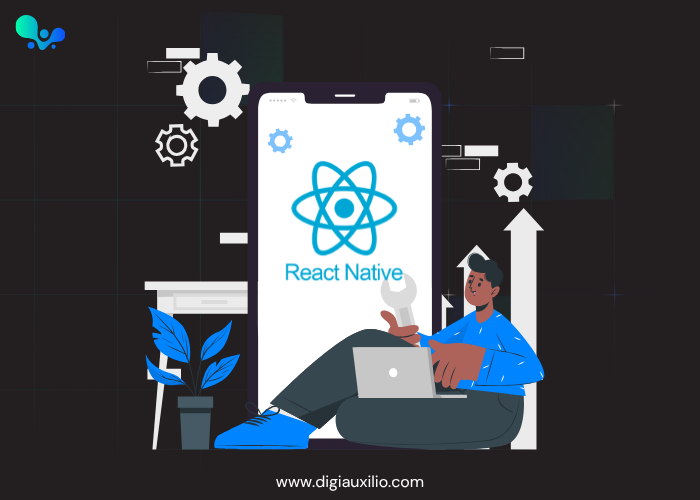Mobile apps are now necessary in the centered around technology world; they are no longer optional. However, creating different apps for iOS and Android may be expensive, time-consuming, and difficult. React Native is a game-changer in the field of developing cross-platform mobile apps in this particular scenario.
React Native, created by Facebook (now Meta), allows programmers to create mobile applications with JavaScript and React which operate natively on iOS and Android devices. This translates into reduced expenses, faster development, and a consistent user experience across platforms.
What is React Native?
With the help of Meta’s robust open-source React Native framework, developers can create mobile apps foriOS and Android with only one codebase. The core of it is React, a popular JavaScript user interface store that allows its components to compile directly into native code, ensuring that the end result will run, feel, and look just like a native app.
noticeably superior speed and user experience than conventional hybrid frameworks like Cordova or Ionic, which mostly rely on WebView.
Key Ways React Native is Transforming Cross-Platform Development
1. Single Codebase for Two Platforms
One of the main advantages of React Native is the ability to reuse code. One code set that is compatible with both iOS and Android is created by developers. This reduces:
- Development time
- Costs
- Maintenance efforts
Two separate teams operating on two different platforms are no longer required. Rather, they can work together on a single codebase, improving efficiency and accelerating time to launch.
2. Near-Native Performance
Real native components are displayed using React Native, closing the gap between native and hybrid programming. This results in:
- Smooth animations
- Fast app performance
- Native-like user experience
When performance-intensive activities are required, developers can still create parts of the application in Swift, Objective-C, or Java/Kotlin because of native modules.
3. Hot Reloading for Faster Development
React Native’s fast reloading functionality allows developers to immediately experience the effects of the latest modifications without the need to restart. It ends up in:
- Faster development cycles
- Immediate bug fixes
- Quicker testing and iteration
It enhances developer productivity and streamlines the entire development workflow.
4. Vibrant Ecosystem and Reusable Components
React Native benefits from a rich set of libraries, plugins, and components that are open-source and actively maintained by a strong developer community.
You can avoid having to start from scratch by using reusable user interface components, which enable:
- Modular development
- Scalable architecture
- Faster feature rollouts
5. Strong Community Support
Backed by Meta and a global community, React Native is constantly evolving. You get access to:
- Frequent updates
- Troubleshooting forums
- Open-source contributions
- Pre-built solutions
This makes it a reliable and future-ready choice for both startups and enterprises.
6. Easy Integration with Third-Party Plugins
GPS, cameras, Bluetooth, push notifications, and other native device functions can be easily integrated with React Native.
- Apps can be feature-rich
- Developers can leverage device hardware natively
- There’s no compromise on user experience
7. Cost-Effective Solution for Businesses
Because you’re working with one codebase and one team, the development cost is significantly lower compared to building native apps separately. This makes React Native an ideal choice for:
- Startups with tight budgets
- SMEs launching MVPs
- Enterprises looking to optimize resources
Who’s Using React Native?
Many top companies trust React Native for their mobile apps, including:
- Instagram: Improved push notification experiences and post-processing.
- Facebook: Several features in the Facebook app use React Native.
- Walmart: Reduced development time and improved performance
- Airbnb (previously): Despite moving back to native, Airbnb saw massive productivity gains with React Native.
- Uber Eats, Discord, Pinterest, and more.
The examples provided show the scalability, adaptability, and practical utility of React Native applications.
Future of React Native
With ongoing improvements in architecture (like the new Fabric Renderer and TurboModules) and support for more complex use cases, React Native is rapidly closing the gap between native and cross-platform apps.
The framework is also becoming more compatible with AI/ML, AR/VR, and IoT, opening new possibilities for advanced app development.
FAQs About React Native
Q1. Is React Native good for large-scale apps?
Yes, React Native is used by a lot of big companies including Facebook, Discord, and Shopify. With proper architecture, modularization, and native module support, it can scale well.
Q2. Can I use React Native with native code that already exists?
Absolutely. You can integrate native modules written in Swift, Java, or Objective-C with React Native for specific use cases like camera access or push notifications.
Q3. Is React Native good for MVPs?
Perfect for MVPs. React Native helps launch cross-platform MVPs quickly, allowing startups to validate their product idea before investing in full-scale native development.
Q4. What kind of apps should avoid React Native?
Apps requiring intensive 3D graphics, complex animations, or low-level system access (e.g., high-end games or AR apps) may perform better with fully native code.
Q5. How secure is React Native?
React Native is as secure as native apps, provided best practices are followed—such as encrypted storage, secure APIs, and regular updates. Security modules and third-party tools are also available.
Conclusion:
React Native is not just another cross-platform tool—it’s a complete ecosystem for building high-performance, cost-effective, and scalable mobile apps. From startups building MVPs to enterprises optimizing digital transformation, React Native offers the perfect mix of flexibility, speed, and native performance.
As mobile technology continues to evolve,frameworks like React Native are bridging the gap between native feel and cross-platform efficiency—truly transforming the way we develop apps today.
